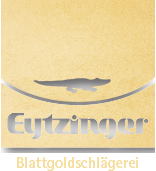Silver leaf and its pitfalls
Silver leaf is used both in water gilding and for silvering with Mixtion and water based goldsize. Silver leaf is made from pure silver and is only suitable for silvering of indoor installations. Immediately after application, the silver leaf must be given a coat of varnish, as otherwise it will begin to oxidise due to contact with the air.
Special characteristics when working with silver leaf
- Silver leaf should only be applied in a workshop or in an environment with low air humidity, as the material oxidises very quickly.
- In workshops in which acids and solvents are being used, fumes must be taken into account. You should not carry out silvering in such a place or store booklets with silver leaf.
- Silver leaf must not be touched with bare hands in order to avoid oxidation stains.
- When applying silver leaf with a gilder’s tip, the tool must not be greased with vaseline as the grease residues prevent a desired and even oxidation.
- Silver leaf can be applied without problem using a gilder’s tip that is wiped down with a cloth been dampened with petroleum. Petroleum evaporates without residue and does not leave residue on the silver leaf.
Varnish for silver leaf and the associated problems
All works with silver leaf must be protected by a coat of varnish against oxidation. If working on small surfaces and picture frames, shellac and zapon lacquer are recommended. Wall surfaces and larger furniture, however, come with a number of challenges.
The majority of varnishes are unfortunately not suited for silver leaf. We have summarised the most frequent problems when using varnish with silver leaf and their causes:
- The silver leaf oxidises underneath the varnish.
- The varnish discolours and turns brown.
- The dried coat of varnish comes away from the silver leaf surface like a film.
In all instances, these problems cause irreparable damage, which requires the entire job to be repeated. There are many reasons as to why these problems occur, and they cannot always be predicted:
- The oxidation of silver leaf can be a result of the substrate. Unsealed or insufficiently dried substrate structures are frequent triggers of this problem. Unsuitable varnishes and too thick varnish layers are also possible causes of this type of problem.
- If the varnish turns brown, this is generally the result of a lack of UV components in the varnish. Other causes could be that the varnish is incompatible with the adhesive or with the silver.
- If the coat of varnish comes away from the silvered surface, then it was simply the incorrect varnish, as only a select few varnishes are suitable for use with silver leaf. At present we can recommend acrylic parquet lacquer, under certain conditions. Because varnish manufacturers are continually optimising their product, each newly purchased container must be tested prior to use on silver.
Intermediate primer as a means of preventing oxidation
An intermediate primer can generally resolve the problems of oxidation and the coat of varnish coming away from silvered surfaces: A thin coat of warm, liquid rabbit-skin glue or gelatine solution is applied to the silver leaf surface. Once the coat of glue has dried, a very thin first layer of varnish can be sprayed on. After further drying time, a second layer of varnish is applied. The rabbit-skin glue serves as both a separating and an adhesive layer, which prevents the oxidation of the silver and the coming away of upper coats of varnish.
Important: tests must be conducted prior to silvering a large area.


